Chicago Road Trip: In Search of the Best Chicago Hot Dog
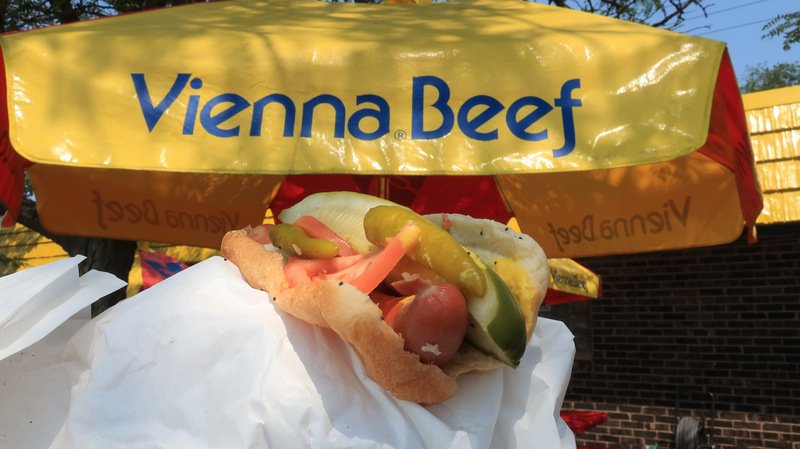
“I’ll take a dog, run it through the garden, in a paper bag to go,” said my friend Danny, mimicking the Chicago accent as he explained how one orders what passes in Chicago for “the works” on a hot dog. I sat on a brutally awkward concrete Mustard’s Last Stand on the edge of the Northwestern University’s campus. My wife Tip and I were in Chicago for the weekend to celebrate both the Fourth of July and National Hot Dog Month.
Origins of an American Classic
The concept of a sausage – chopped or ground meat in a casing – lies far enough back in history, predating nation states, so to make any direct claims on the concept’s creation is moot. Its origins are “lost in the mists of time,” writes Bruce Kraig, PhD, professor emeritus in history and humanities at Roosevelt University and adjunct faculty at the Culinary School of Kendall College. In Hot Dog: A Global History he tells us archaeologists have found evidence of meats in animal gut as far back as the Upper Paleolithic 20,000 years ago.
The hot dog, however, is a truly American food, with its origins, of course, in immigration. We also call them franks – short for Frankfurter, from Frankfurt, Germany –and wieners, as in from Wien (Vienna). So we can at least see right away that German immigrants put their mark on them here in the United States.
Myths abound as to the name origin – a World’s Fair, Coney Island, and various ballparks – but Kraig digs through the filler to find the meat of the story: a food cart in the 1890s The Kennel Club near Yale, soon referred to as the Dog Wagon, serving a sausage in a split bun. Others followed. Klein’s book documents references to these carts, and the hot dog subsequently appeared in magazines, cartoons, and songs. Recent arrivals in America, Germans were mocked for their accents, and jokes were made at their expense – including some that suggested dogs made it into their sausage recipes. You still see Dachshunds wearing buns in hot dog stand logos.
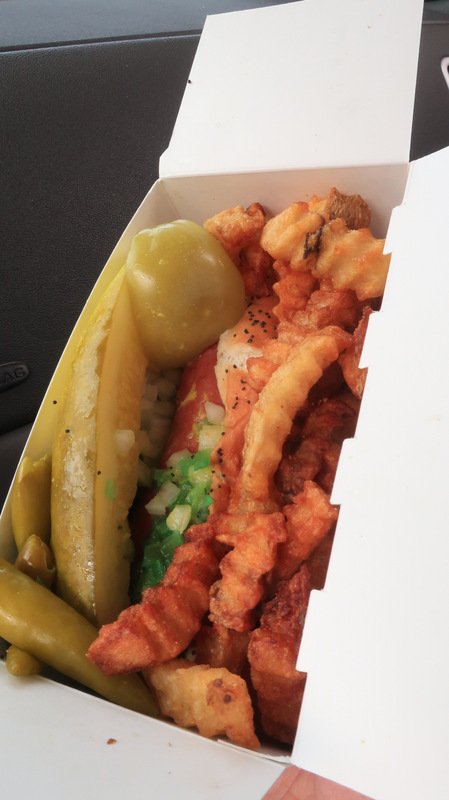
Chicago-style Dogs
Even today jokes abound about the ingredients of a hot dog. Yet we still eat them like crazy in all parts of the country (and even the world). Many places have become associated, however, with a very specific way to dine on a dog. Rules, you might say. So the hot dog unites us as much as it distinguishes our individuality. E pluribus unim. From the many, one. So the hot dog unites us, yet each person has their individual favorite or a particular way of preparing them. A favorite brand, a favorite stand, and a specific medley of condiments – but in the end, they are all hot dogs.
In 1865, Chicago’s Union Stockyards opened and soon saw millions of animals arriving annually in the meatpacking district, compelling poet Carl Sandburg to dub the town “Hog Butcher for the World” in his 1914 poem “Chicago.” Unsurprisingly, Armour & Co. and Oscar Mayer got their starts in Chicago, and in 1893, Austrian-Hungarian immigrants Emil Reichel and Samuel Ladany founded Vienna Beef. The partners debuted their frankfurters at the Columbian Exposition, Chicago’s World’s Fair that same year.
My Chicago friend and food-enthusiast Geoff Burton happily informed me of the basics: a Vienna Beef hot dog in a poppy-seed bun, topped with tomato, onion, celery salt, sport peppers (short, pickled, medium-spicy green peppers similar to a pepperoncini), a pickle spear, piccalilli (a pickle/green tomato relish often the bright green color of a candied cherries), and yellow mustard. And good lord, do not ask for ketchup, positively verboten by the faithful. Chicago dogs are typically steamed or char-grilled; not boiled and never on a roller like at the gas station. Natural casing is not required, but it does give the dog that marvelous snap when you bite into it.
My own personal favorite, first eaten when I lived in Chicago back in 1991, is from The Wiener’s Circle, famed for its brusque yet endearingly profane treatment of customers. They are under renovations at the moment, soon to reopen serving alcohol, but I remember them as the ultimate late-night stop with a bit of comedy. Their char-dogs should be on any short list of Chicago dog stands.
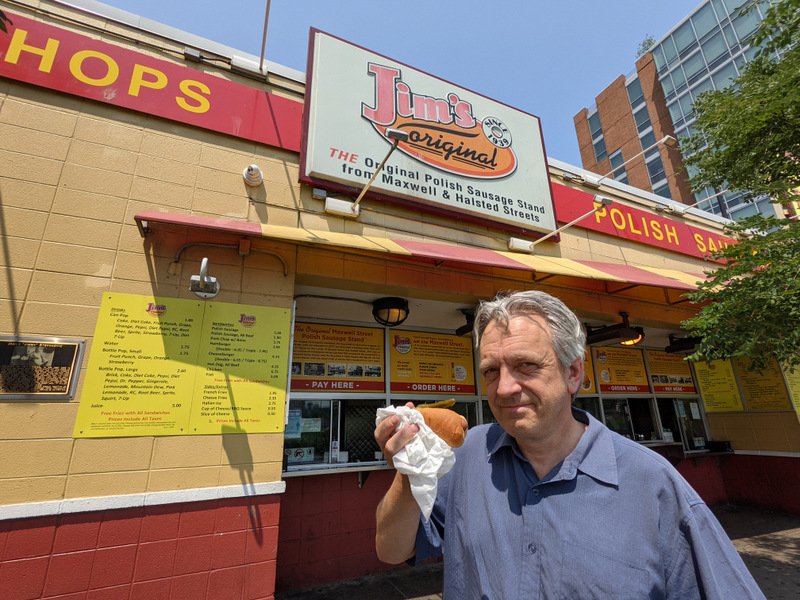
Windy City Dog Joints
I had checked in with Geoff Burton, an old friend, Chicago resident, and expert on all delicious things, to help put together a short itinerary of great places to go Chicago-style.
He prefers them char-grilled (a char-dog) and smothered with a good cheese sauce. (See The Wiener’s Circle). To be clear, this list is nowhere near exhaustive, nor is it ranked. There are no losers here – only wieners.
In the 19th century, the Maxwell Street Market opened in what was then the Jewish quarter of Chicago. As the bustling market and neighborhood grew it was often referred to as “the Ellis Island of the Midwest.” Unlike the traditional frankfurters which contained a mix of pork and beer, the Jewish sausages went all beef. The mere absence of pork didn’t necessarily make them all kosher, but the general public had the impression that these were higher quality dogs. Abe “Fluky” Drexler opened Fluky’s Red Hots in 1929, the first hot dog stand in Maxwell Street. Others followed. When Maxwell Street fell to development and the market moved, vendors were cast about town or closed altogether.
Our first dog of the day was at one of the survivors: Jim’s Original, most famous for its Maxwell Street Polish sausage. Open 24/7, Jim’s makes a great late-night stop and its location right off I-90 just south of Roosevelt makes it your quickest stop if just passing through town. My sport pepper was a larger pickled pepper that left me hiccupping at the heat. The pre-prepped, sweet grilled onions may seem a bit soggy, but these were delicious nevertheless. All come with a side of crispy French fries. This is a stand with a sidewalk counter along the wall; at the other end of the building is their burger stand if that’s your thing. Easy in and out with street parking.

Our next southside stop was central to all true Chicago dogs: Vienna Beef. Founded in 1893 in Maxwell Street, the sausage maker grew to factory sized proportions and they now operate a store across the street from the factory. You can stock up on all things hot dog (skinless or natural casing) plus the precise (and branded) toppings. The store also serves as a hot dog stand, with a standup counter inside and picnic tables outside. Not getting to Chicago soon? They will ship you any of the ingredients, including a couple “kits” only available on their website. Look for the Vienna Beef logo in the signage at any proper hot dog location. The company loves the brand loyalty and inducts vendors into their hall of fame each year.
I fumbled with my hot dog and camera outside. “Gimme ya camera!” said a burly guy, without introduction, wiping his hands on his pants from where he left his dog at a table under a Vienna Beef umbrella. My startled look prompted him to add, with a stereotypical Chicago accent to put a Saturday Night Live sketch to shame. “Get a picture of you two.” (He may or may not have said “yous.”) Tip and I posed under the Vienna Beef sign. He snapped a few shots and returned to his meal.
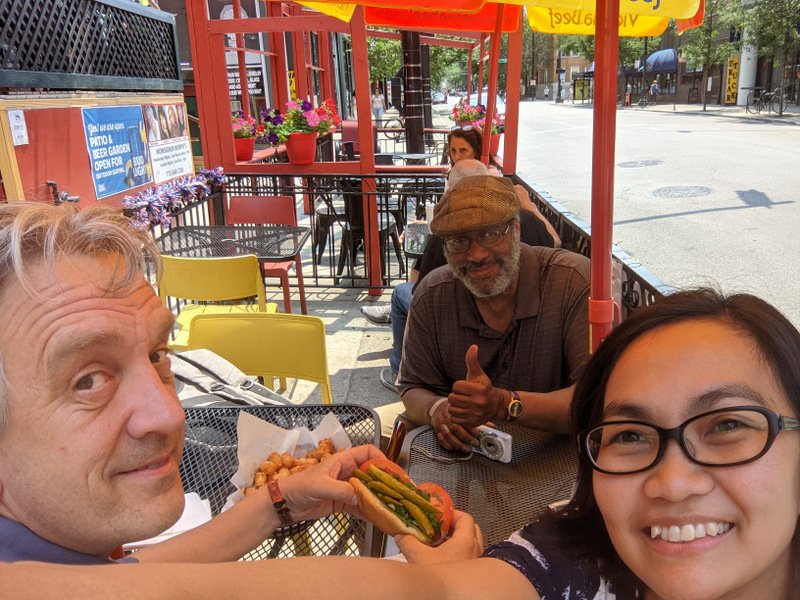
Geoff joined for stops 3-5. We hit a basement restaurant in a repurposed red-brick walk-up: Flub A Dub Chub’s, which has won awards in the 15 years since it opened. Rosemary Giarratano – a wry, seen-it-all member of the Giarratano family that owns and operates the joint – brought out a Flubby, the signature Chicago dog, and the most perfectly prepared and photogenic one we had that day, with a side of tater tots. At this point I misidentified it as my order but it was for the next table. I ended up delivering it with Rosemary after the mix up at which point she fired me on the spot. Thus making this the fastest I’ve ever gone through the hire and fire process. Probably. One can add cheese sauce, chili, and/or a bacon wrap here, and the menu offers 14 dog recipes, including a vegan option. Frankly, I loved this place.
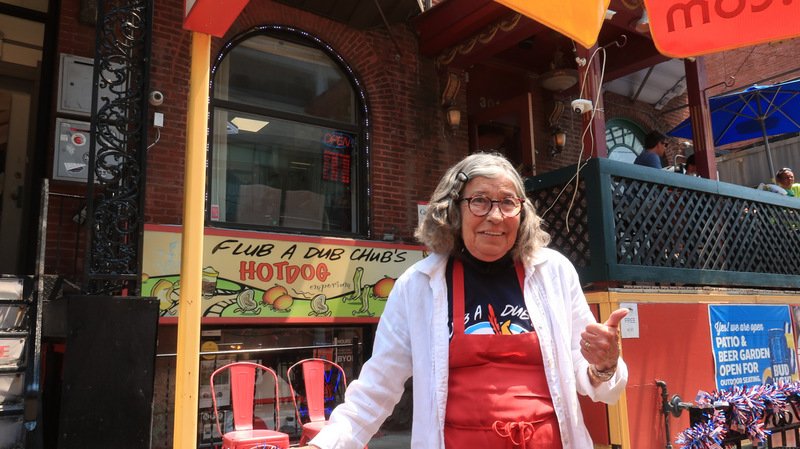
Next stop: Fatso’s Last Stand, and Geoff finally got his char-dog of the day. All the usual ingredients plus a side of house fries, a line up of Jarritos sodas, and some interesting milkshake flavors, including “Irish Coffee,” with the expected whiskey.
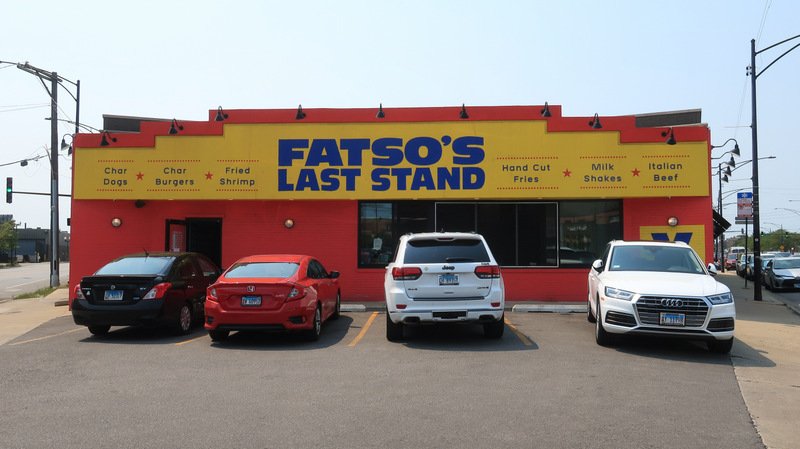
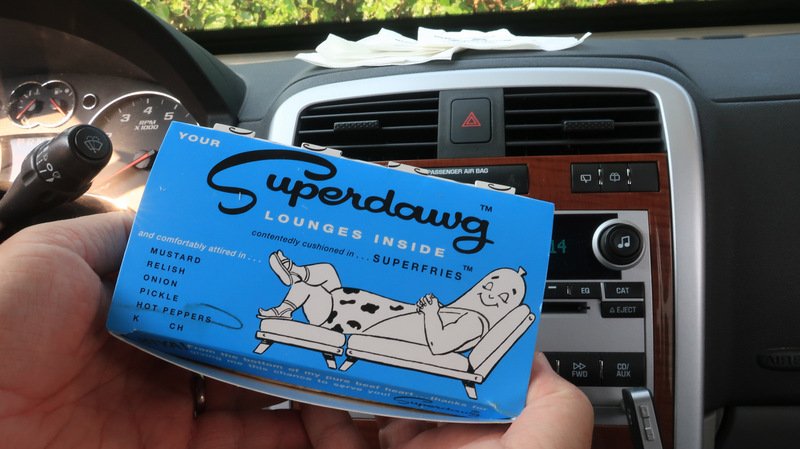
Superdawg combines the All-American food with the All-American drive-in. Stay in the car, order at the car-side speaker and lighted menu, and a carhop brings your order. (Sorry, no roller skates.) These were all beef, but not Vienna brand and a bit thicker. They come with fries and a pickled green tomato slice among the toppings all in a handy little cardboard box which really helps keep your food off your clothing better than the typical paper wrapping. Come in the evening to see the hot dogs Maurie and Flaurie light up on top of the building.

After bidding farewell to Geoff, we shared dogs with more friends at Mustard’s Last Stand, before finishing the day at another institution: Gene & Jude’s. Founded in 1946 by a couple of city workers, Gene Mormino and Jude DeSantis got inspired when they felt their ballpark dogs at a Cubs game were missing something. Not fries with that but fries on that. Their hot dog stand has been a fixture in River Grove, IL since 1950, in a white-tiled building with big lighted signs along the awning for each item on the short menu.
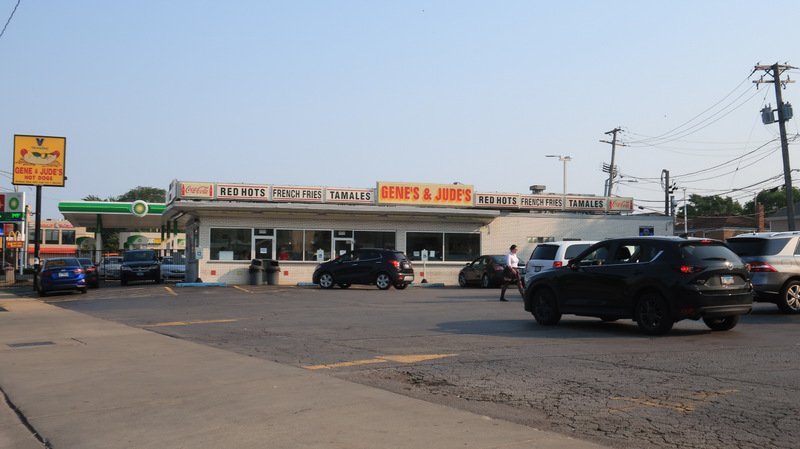
Inside, the line was fairly long but then so was the line of employees behind the counter, taking orders and moving them out quite quickly. “No seats, no ketchup, no pretense, no nonsense” reads their website. The wall in the spacious counter area is adorned with awards and feature articles. What you get here is known as a Depression Dog, based on simple cheap frankfurters of old, without the mountain of toppings. Mustard, relish, onions, and sport peppers are optional, and there are no pickles or celery salt. The fries are hand-cut and laid right on top of the dog. Along with the dogs you can order tamales. A marvelous twist and reminder of everyone putting their own spin on American food.
We drove back to Wisconsin, stuffed and quite sick of hot dogs. As we rolled into town that evening, neighbors celebrated the 4th of July with a cook out. Working the grill, Neighbor Jerry raised his tongs in greeting. “Hot dog??”
I sighed. “Sure, why not?” Who can say no?



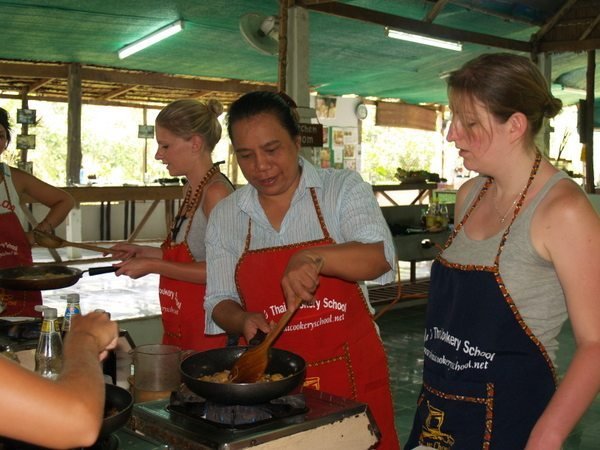

 ORDER YOUR COPY TODAY!
ORDER YOUR COPY TODAY! ORDER YOUR COPY TODAY!
ORDER YOUR COPY TODAY!
Great history information and great stops list for Chicago hot dog! Peung
If I’m being frank, that was article was a real wiener. Yup, pretty dog gone good!